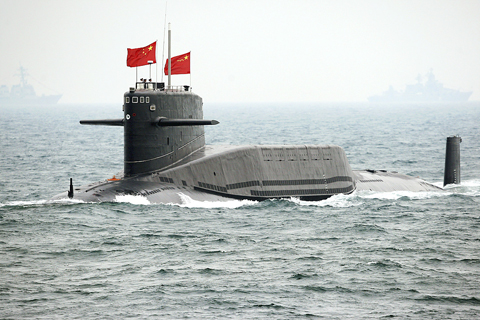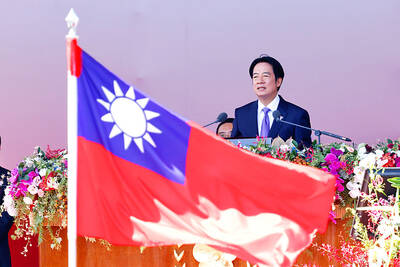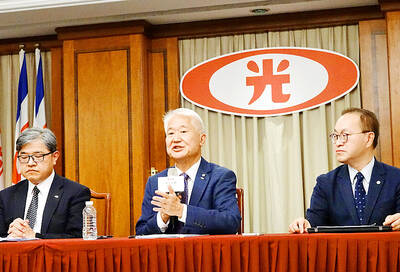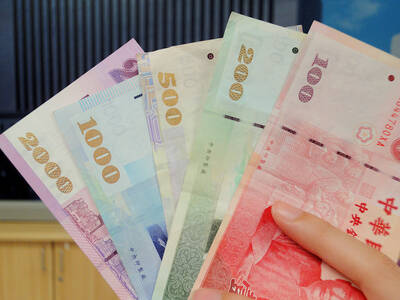Chinese President Hu Jintao (胡錦濤) presided yesterday over an international naval review in the northern port of Qingdao that highlights Beijing’s ambitions of becoming a major sea power.
Ships and naval aircraft from China and 14 other countries took part in the display in the East China Sea, the first-ever hosted by the People’s Liberation Army Navy (PLAN) in honor of its 60th anniversary.
Hu announced the start of the display from aboard the Chinese destroyer Shijiazhuang accompanied by the Chinese navy’s commander, Admiral Wu Shengli (吳勝利), Defense Minister Liang Guanglie (梁光烈) and other top military brass.

PHOTO: AP
Two Chinese nuclear submarines took part, state media said, the first known public display of the potent naval weapons.
Earlier, Hu met with US and other foreign naval commanders, telling them China supported increased cooperation among navies to safeguard maritime safety.
“Strengthening exchanges between the navies of all countries and embarking on international maritime safety cooperation substantially contributes to the building of harmonious oceans and seas,” Hu said.
The president also repeated China’s position that the country would never threaten other nations or seek regional dominance and that its military “will always be a force for the preservation of world peace and advancement of common development.”
The gathering was portrayed by state media as a signal of China’s intent to develop its navy into a force able to conduct operations far from home ports in defense of the country’s maritime trade.
Those plans are believed to include the addition of one or more aircraft carriers to the fleet over the coming years, possibly emboldening China in enforcing its territorial claims in the South China Sea and elsewhere.
China deployed its anti-piracy patrol to Somalia in December in a rare joint operation with other navies. It was the first time China had dispatched ships abroad on a combat mission.
The PLAN operates more subs than any other Asian nation, with up to 10 nuclear-powered vessels.
The country’s nuclear-powered Jin and Shang class submarines are considered just a notch below cutting-edge US and Russian craft. Its diesel-electric Yuan class also boasts an indigenously developed air-independent propulsion system that allows vessels to remain submerged for weeks.
Xinhua news agency said Chinese vessels participating in the half-hour display included two diesel-electric and two nuclear submarines, five missile destroyers, six frigates, and a large amphibious landing ship.
Other countries participating included Australia, Brazil, France, India, South Korea, Pakistan and Russia. Admiral Gary Roughead, chief of naval operations, represented the US Navy at the events, along with the guided missile destroyer USS Fitzgerald.
Japan sent Vice Admiral Koji Kato, but did not participate in the naval review in deference to Chinese sensitivities over Japan’s World War II invasion. Japanese forces controlled Qingdao from 1914 to 1922 and again from 1938 to 1945.

People can preregister to receive their NT$10,000 (US$325) cash distributed from the central government on Nov. 5 after President William Lai (賴清德) yesterday signed the Special Budget for Strengthening Economic, Social and National Security Resilience, the Executive Yuan told a news conference last night. The special budget, passed by the Legislative Yuan on Friday last week with a cash handout budget of NT$236 billion, was officially submitted to the Executive Yuan and the Presidential Office yesterday afternoon. People can register through the official Web site at https://10000.gov.tw to have the funds deposited into their bank accounts, withdraw the funds at automated teller

PEACE AND STABILITY: Maintaining the cross-strait ‘status quo’ has long been the government’s position, the Ministry of Foreign Affairs said Taiwan is committed to maintaining the cross-strait “status quo” and seeks no escalation of tensions, the Ministry of Foreign Affairs (MOFA) said yesterday, rebutting a Time magazine opinion piece that described President William Lai (賴清德) as a “reckless leader.” The article, titled “The US Must Beware of Taiwan’s Reckless Leader,” was written by Lyle Goldstein, director of the Asia Program at the Washington-based Defense Priorities think tank. Goldstein wrote that Taiwan is “the world’s most dangerous flashpoint” amid ongoing conflicts in the Middle East and Russia’s invasion of Ukraine. He said that the situation in the Taiwan Strait has become less stable

CONCESSION: A Shin Kong official said that the firm was ‘willing to contribute’ to the nation, as the move would enable Nvidia Crop to build its headquarters in Taiwan Shin Kong Life Insurance Co (新光人壽) yesterday said it would relinquish land-use rights, or known as surface rights, for two plots in Taipei’s Beitou District (北投), paving the way for Nvidia Corp to expand its office footprint in Taiwan. The insurer said it made the decision “in the interest of the nation’s greater good” and would not seek compensation from taxpayers for potential future losses, calling the move a gesture to resolve a months-long impasse among the insurer, the Taipei City Government and the US chip giant. “The decision was made on the condition that the Taipei City Government reimburses the related

FRESH LOOK: A committee would gather expert and public input on the themes and visual motifs that would appear on the notes, the central bank governor said The central bank has launched a comprehensive redesign of New Taiwan dollar banknotes to enhance anti-counterfeiting measures, improve accessibility and align the bills with global sustainability standards, Governor Yang Chin-long (楊金龍) told a meeting of the legislature’s Finance Committee yesterday. The overhaul would affect all five denominations — NT$100, NT$200, NT$500, NT$1,000 and NT$2,000 notes — but not coins, Yang said. It would be the first major update to the banknotes in 24 years, as the current series, introduced in 2001, has remained in circulation amid rapid advances in printing technology and security standards. “Updating the notes is essential to safeguard the integrity